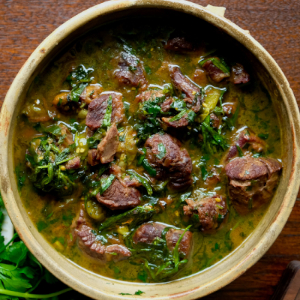Last week, we explored the unique, creative cuisine of California; a state, not a country, and a place many of us thought we already knew all about. Now we know. This week, we’ll visit Georgia – the country, not the state. Hint: It’s in Eastern Europe and, unlike California, it’s mostly mountains…
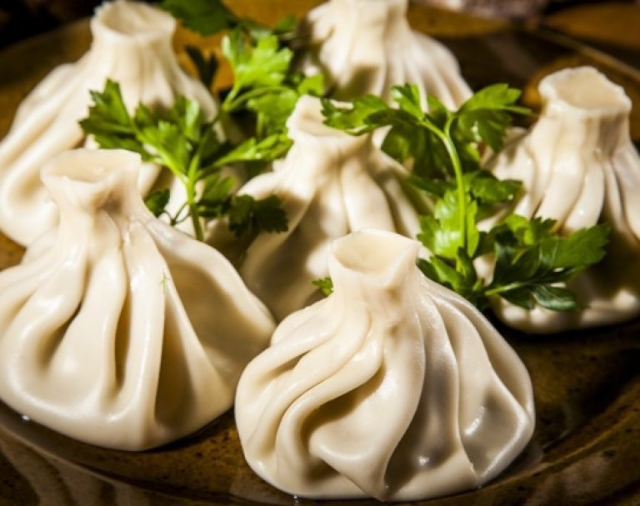 Khinkali: Traditional Georgian Dumplings – THE national dish!
Khinkali: Traditional Georgian Dumplings – THE national dish!
Okay. I know you’re thinking, “Who is the ‘George’ behind Georgia? How did a George end up in this land of Igors and Nadias? This former Soviet satellite?”
Good, old Wikipedia has the answer, as usual: “Georgia is the Western exonym for the country in the Caucasus natively known as Sakartvelo. The Russian exonym is Gruziya ), while in Armenian it is Vrastan. […] Both endonym and exonym for the country are derived from the same state-forming core and central Georgian region of Kartli around which the early medieval cultural and political unity of the Georgians was formed. […] All external exonyms are likely derived from gorğān, a Persian name meaning ‘the land of the wolves’.”
Got it? The bottom line is, there is ‘Georgia’, and then there is ‘Georgia’. Totally different, totally distinct and totally unrelated. Except, perhaps, for folks whose families moved to one from the other at one point. But that’s neither here nor there.
About the one we’re visiting this week…
Wikipedia does the job better than I could, again: “Georgia is a country located at the intersection of Eastern Europe and Western Asia. It is a part of the Caucasus region, bounded to the west by the Black Sea, to the north and east by Russia, to the south by Turkey and Armenia, and to the southeast by Azerbaijan. It covers 69,700 square kilometres (26,911 sq mi), and has a population of around 4 million. […] Tbilisi is the capital and largest city, home to roughly a quarter of the population.”
So what do they eat, already?
I know you’ve patient. Now, the payoff. It’s finally time to get into the Georgian national cookbook! There are a number of popular Georgian dishes that closely resemble those from other Caucasian countries, like ground meat kebabs and meat chunks on a skewer, not to mention a whole flock of soups and salads. Today, we’ll focus on specifically Georgian dishes.
Food bloggers who’ve actually been there insist that Georgian cuisine – though heavily influenced by its neighbours – is unique and distinctive. And one look at a list of favourite national dishes proves the point…
Spices and Condiments
Traditional spices and condiments are esserntial to Georgian cooking. The fave national dishes of Georgia are just not the same without them!
Svan Salt is a spice mix available in every grocery store, and used by every Georgian cook. It’s a blend of sea salt, garlic, fenugreek, coriander, chili pepper, dill and other herbs. Think Mrs. Dash on steroids.
Ajika is another seasoning blend you’ll keep hearing about when you start to cook Georgian. There are several kinds. The popular Red Ajika is a blend of mild red peppers and a list of other herbs and spices to rival Colonel Saunders’. It comes in dry and paste versions which are rubbed on raw meats to impart bigger flavour when roasting.
Tkemali: A sour wild plum sauce flavoured with with garlic, dill, coriander, and chilis. It comes in Red and Green versions.
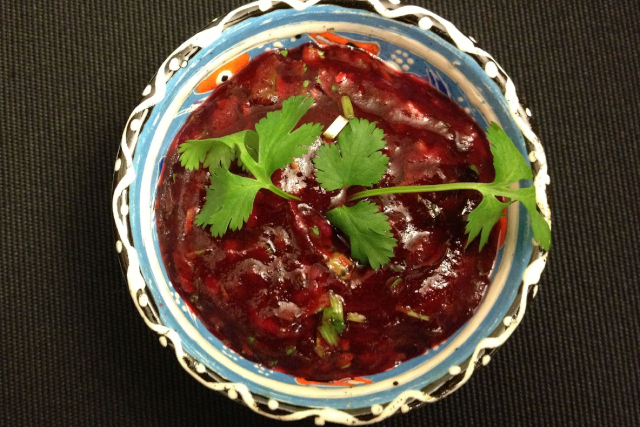
Georgians use it like Westerners use ketchup. But the flavour is completely different. Iy’s also a favourite flavouring ensemble for Georgian marinades and a classic condiment.
Khmeli suneli: The Georgian version of what Indians call Masala, or signature regional spice blend, featuring dried local herbs such as coriander, marigold, fenugreek, dill, mint, parsley and marjoram. It’s an absolute must to make authentic versions of many Georgian dishes.
Favourite National Dishes
Khinkali is the top dish on nearly every list of most famous, most beloved Georgian foods. Quite an honour for a simple dumpling! But Khinkali are not so simple – if you want to get them right! And the etiquette to eating them is also special: You pluck then our of your soup or off a plate by their stem-like tops, sprinkle them with pepper and then, suck our the juice. Only then can you politely start to chew. They’re served everywhere.
Ojakhuri: A classic Georgian family dish – like a stew but without the juice or sauce. It’s composed of chunks of boneless pork, potatoes, onion and garlic, roasted together and served in a traditional clay pot.
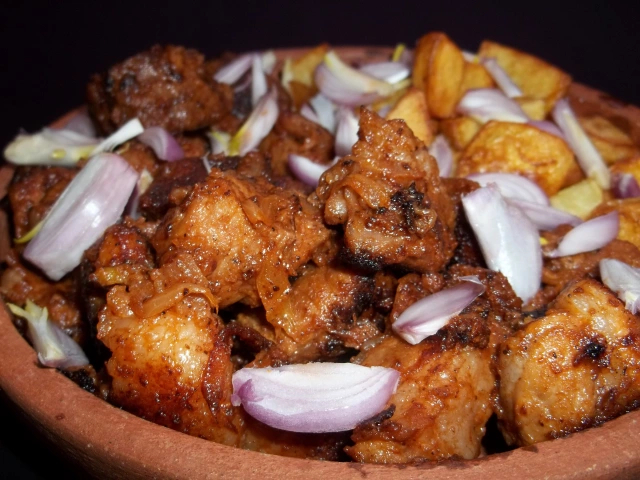
During cooking, it nearly swims in pork grease. But that’s all drained off before serving.
Ostri/Chashushuli: A hearty, dark red stew superficially resembling European Goulashes. It has two names because it comes in two styles: With Ostri is all the ingredients are cooked together at the same time, in the same pot. For Chashushuli, the meat is first fried to develop a strong beef flavour, then cooked further in its own fat:

The fat is drained before the tomatoes, mushrooms and spices are added, after which the strew is left to simmer long and low.
Shkmeruli Chicken: Roasted Chicken parts stewed in Garlic Sauce. The flavour, along with being richly garlicy, has a not-unpleasant sharp edge. This is considered a fancy dish and is one of the more expensive ones you’ll find on Georgian restaurant menus.
Tabaka Chicken: Flattened Roasted Chicken. Here’s a chance for you to practice your spatchcocking technique while preparing a classic Georgian main. The chicken is simply fried for 25 – 30 minutes per side in a heavy (cast iron is ideal) pan, weighted down by a heavy object – another, smaller iron fry pan is ideal. Or you can use a couple of ordinary construction bricks wrapped in foil.
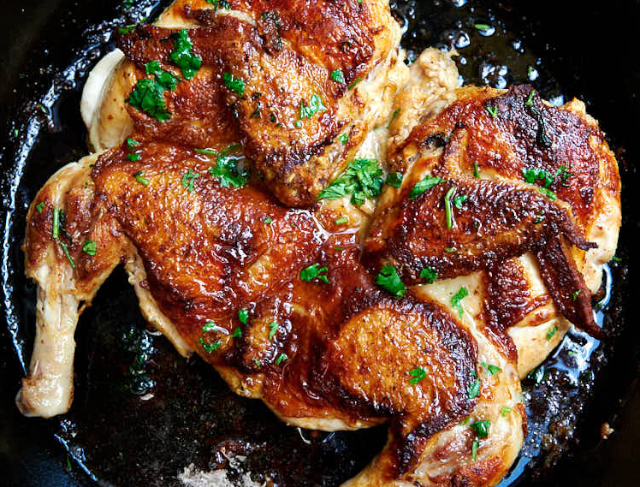
‘Comes out deep browned and crispy on the outside and stays white and juicy on the inside. Often used as the featured ingredient in other dishes that add a starch and veggies for a complete meal. Serve with sour plum Tkemali sauce.
Chakapuli: A stew that’s singularly Georgian, featuring locally beloved ingredients. Use any meat you wish; chicken is traditional. Stew it with a good bunch of fresh tarragon leaves and tkemali sauce – or better yet, fresh sour plums. Some folks add mushrooms. The broth is rich and meaty with a nice sour note.
And that’s your primer on Georgian mains
No fried chicken, grits or okra, here! Just kidding. Seriously… You know know atleast one place in the world where they love fenugreek! Tomorrow, we’ll look at Georgian breads and baked goods, some for sides and some that constitute mains. But all from the oven.
~ Maggie J.

